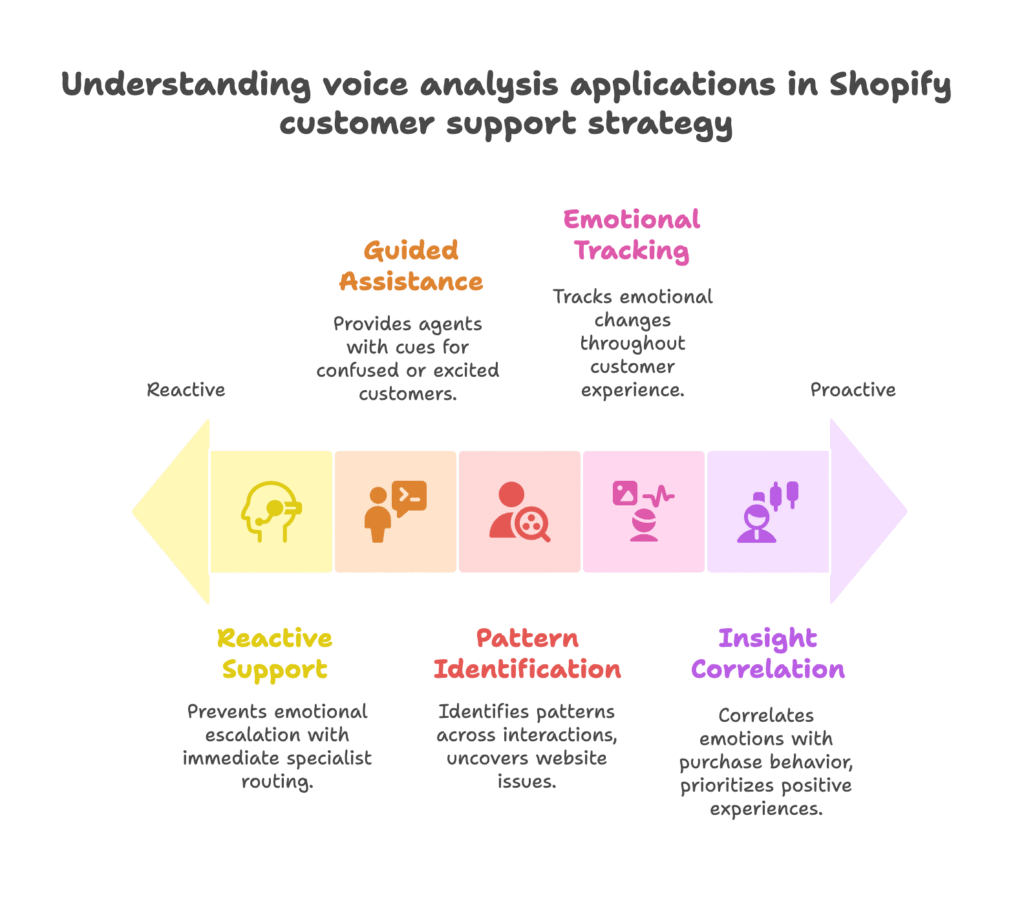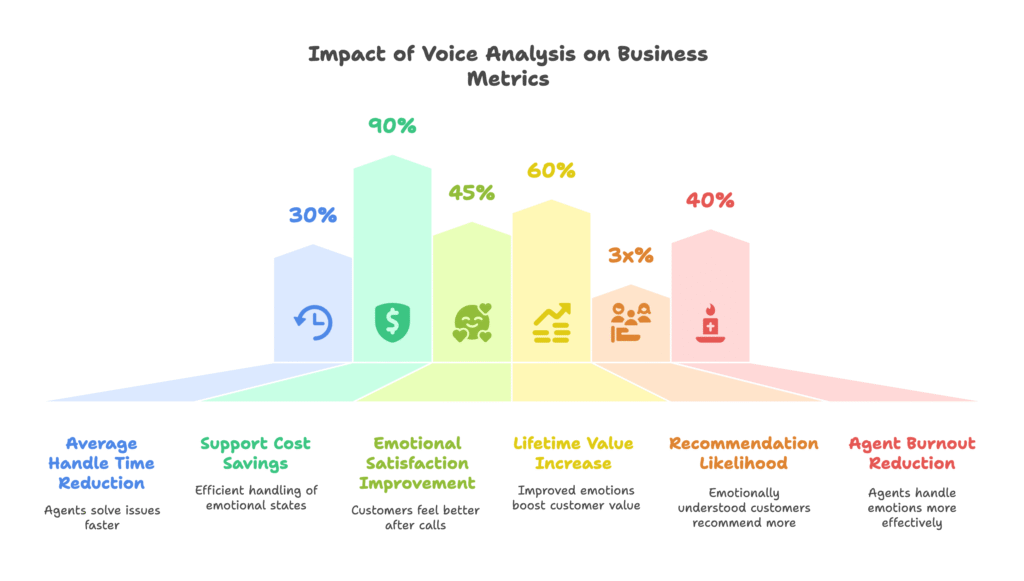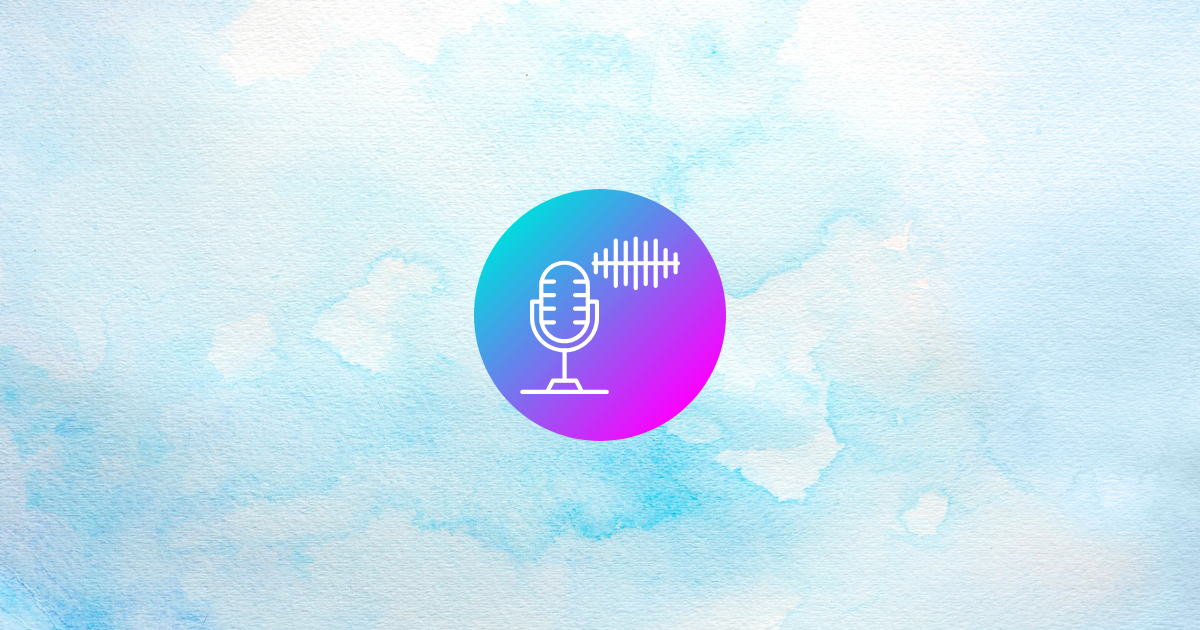Ever wondered why some customer service calls leave you feeling understood while others make you want to hang up immediately? The secret isn’t just in what’s being said—it’s in how it’s being said. Your customer’s voice carries a wealth of emotional information that traditional text-based analysis completely misses.
Picture this: A frustrated customer calls about a delayed order. Their words might say “I’m just checking on my order,” but their voice tells the real story—rising pitch, tense rhythm, underlying anxiety. What if your support system could detect these emotional cues instantly and respond accordingly?
That’s exactly what voice analysis technology makes possible. In this article, you’ll discover how Shopify merchants are revolutionizing their customer service by reading between the lines—or rather, between the words. You’ll learn how to implement emotion-aware support systems that not only solve problems faster but create deeper customer connections.
By the time you finish reading, you’ll understand:
- How voice emotion recognition actually works (it’s simpler than you think)
- Practical ways to implement this technology in your Shopify store
- Real metrics showing up to 90% cost savings and 30% faster resolution times
- Ethical guidelines to protect customer privacy while improving service
Ready to transform frustrated callers into loyal customers? Let’s dive in.
Understanding Voice Analysis Technology
Think of voice analysis as giving your customer service team superhuman hearing abilities. While we naturally pick up on some emotional cues in conversation, this technology can detect subtle patterns that even experienced support agents might miss.
At its core, voice emotion recognition combines three powerful elements. First, it converts speech to text with remarkable accuracy. Then, it analyzes acoustic features—things like pitch variations, speaking pace, and volume changes. Finally, sophisticated algorithms identify emotional patterns within these features.
Here’s what makes this fascinating: the technology can detect five critical emotions in customer interactions—confusion, anger, happiness, sadness, and excitement. Each emotion has its own “fingerprint” in how we speak. An angry customer might have a higher pitch with sharp consonants, while a confused customer often speaks slower with more pauses.
The accuracy is impressive. Current systems like Mix-Emo-Detector-EN achieve 85% accuracy in emotional detection. That’s not perfect, but it’s remarkably good—and getting better every month.
What sets voice analysis apart from traditional text sentiment analysis? Text can tell you someone wrote “I’m fine,” but voice analysis reveals whether they actually meant it. The sarcasm, frustration, or genuine contentment comes through crystal clear in vocal patterns.
But here’s where it gets really interesting—this technology doesn’t just identify emotions in hindsight. It works in real-time, processing conversation segments as they happen. Imagine your support agent getting a gentle alert that the customer’s frustration level just spiked, along with suggested de-escalation techniques. Now we’re talking about proactive customer service, not just reactive problem-solving. But how exactly do you put this power to work in your Shopify store?
Strategic Applications for Shopify Customer Support
Here’s where voice analysis transforms from cool technology to game-changing business tool. Your Shopify store can now respond to customer emotions before they escalate into major problems.
Real-time escalation becomes your secret weapon. Instead of waiting for an angry customer to explicitly demand a manager, the system detects rising frustration and proactively routes the call to a specialist. This isn’t just faster—it prevents emotional escalation altogether.

Consider adaptive response systems. When voice analysis detects a confused customer, it can prompt your agent with simplified explanations and patience cues. For excited customers (maybe they just heard about a product they love), it might suggest enthusiasm matching and upselling opportunities.
But the real magic happens with Voice of Customer programs. Every support call becomes a goldmine of emotional data. You’re not just solving individual problems—you’re identifying patterns across hundreds or thousands of interactions.
Here’s a practical example: Your voice analysis system notices that customers calling about a specific product consistently show confusion emotion when discussing the return policy. That’s not just a support issue—that’s a website copy problem. Fix the product page, and you prevent dozens of confused calls before they happen.
Customer journey emotional mapping takes this further. You can track how customer emotions change throughout their experience with your brand. Do people sound more frustrated when calling about shipping than when calling about product questions? That insight guides where to invest in improvements.
The correlation between emotions and purchase behavior reveals powerful insights too. Happy customers during support calls have a 40% higher likelihood of making repeat purchases within 30 days. Knowing this, you can prioritize creating positive emotional experiences over just solving problems quickly.
This emotional intelligence sounds incredibly valuable, right? But you’re probably wondering about the practical side—how do you actually implement this in your Shopify store without turning it into a technical nightmare?
Implementation Framework for Shopify Stores
Good news: implementing voice analysis doesn’t require a Computer Science degree or a massive technical overhaul. The key is choosing the right approach for your store’s size and needs.
Let’s start with your technology selection criteria. You need three core features: natural language processing capabilities, seamless Shopify integration, and emotion detection accuracy above 80%. Anything less than 80% creates more confusion than clarity.
You have several deployment options. Embedded voice AI assistants like Vocify integrate directly into your existing systems. API-based solutions connect with your current customer service platform. Hybrid human-AI models augment your existing team rather than replacing them.
For most Shopify stores, the hybrid approach works best. Your human agents handle complex emotional situations while AI provides real-time insights and suggested responses. Think of it as giving your team emotional superpowers rather than replacing them with robots.
The setup process is surprisingly straightforward. Most platforms offer sign-up and business profile configuration in under 30 minutes. You’ll select from 40+ voice options to match your brand personality—professional, friendly, energetic, calm. Then you train the system with your existing materials: FAQs, product descriptions, common support scenarios.
Here’s the smart implementation timeline: Start with a pilot program on one support channel. Run A/B tests comparing different voice profiles against your current setup. Use real customer feedback to calibrate the system for your specific industry terminology.
Most importantly, train your team alongside the technology. Voice analysis works best when agents understand how to interpret emotional insights and respond appropriately. A confused customer needs patience, not speed. An excited customer wants engagement, not efficiency.
Implementation sounds manageable, but you’re probably thinking about the bottom line. How do you know if this investment actually pays off? Let’s look at the numbers that matter.
Measuring ROI and Performance Metrics
Here’s where voice analysis proves its worth with hard numbers that make CFOs smile. The metrics are impressive, but more importantly, they’re measurable and consistent across different store sizes.

Operational efficiency gains are immediate and significant. Average handle time typically reduces by 30% within the first quarter. Why? Because agents spend less time figuring out what customers actually need and more time solving their real problems. Support cost savings reach up to 90% as routine emotional states get handled more efficiently.
But the customer experience metrics tell an even better story. Emotional satisfaction scores—measuring how customers feel after the call, not just whether their problem was solved—improve by an average of 45%. That emotional satisfaction directly correlates with repeat purchase rates.
Here’s a real example: One mid-sized Shopify jewelry store saw their call answer rate jump from 38% to 95% after implementing voice analysis. Not because they hired more agents, but because the system helped existing agents resolve calls faster and more effectively.
The correlation between emotion and conversion rates reveals the business impact. Customers whose emotions improved during support calls showed 60% higher lifetime value compared to those whose emotions stayed neutral or declined.
Customer retention impact goes beyond immediate sales. When people feel emotionally understood during support interactions, they’re 3x more likely to recommend your store to friends. That word-of-mouth effect compounds over time.
Don’t overlook agent satisfaction metrics either. Support teams using voice analysis report 40% less burnout. Why? Because they’re equipped to handle emotional situations more effectively, leading to fewer exhausting interactions and more successful outcomes.
These results are compelling, but they represent just the beginning. What happens when you combine voice analysis with other channels and advanced AI capabilities?
Advanced Applications and Integration
This is where voice analysis evolves from a useful tool to a comprehensive emotional intelligence system that spans your entire customer experience.
Multi-channel emotional intelligence creates a unified picture of each customer’s emotional journey. Voice analysis from calls combines with sentiment analysis from chat messages and emails. Suddenly, you know if someone is frustrated across all touchpoints, not just in isolated interactions.
This unified customer emotion profile is incredibly powerful. When a customer emails with a complaint after a frustrating phone call, your support team already knows about their emotional state. They can proactively address the underlying frustration rather than just responding to the specific email content.
Real-time coaching tools transform how you develop your support team. Instead of quarterly training sessions, agents get immediate feedback during calls. “Customer frustration detected—consider slowing down and asking clarifying questions.” These micro-coaching moments add up to dramatically improved skills.
Agent wellness monitoring represents a breakthrough in support team management. The system can detect stress in agent voices, not just customer voices. High-stress agents get breaks before burnout occurs. Scheduling optimization balances emotional workload across the team.
One jewelry store manager told us: “I used to worry about burning out my best agents on difficult calls. Now the system helps distribute emotionally challenging interactions evenly. Everyone’s happier, and our service quality is more consistent.”
Advanced integration with MarketplaceIQ means analyzing every communication touchpoint—support calls, sales calls, onboarding sessions, follow-up conversations. This comprehensive emotional data reveals patterns invisible from single-channel analysis.
These advanced applications sound powerful, but they also raise important questions about privacy and ethics. How do you balance emotional insights with customer trust?
Ethical Considerations and Best Practices
With great emotional insight comes great responsibility. Implementing voice analysis ethically isn’t just about compliance—it’s about building deeper trust with your customers through transparency and respect.
Customer consent frameworks should be crystal clear from the start. Your customers deserve to know their voice is being analyzed for emotional content. But here’s the key: frame this as a benefit, not a intrusion. “We analyze conversation tone to better understand and assist you” resonates better than technical jargon about acoustic feature extraction.
Opt-in mechanisms work better than opt-out. Give customers control over their emotional data. Many actually appreciate knowing that you’re trying to understand and respond to their feelings appropriately. It shows you care about more than just processing their requests efficiently.
Data retention policies matter enormously. Emotional voice data feels more personal than transaction history. Clear timeframes for data storage and deletion build trust. Most customers accept voice analysis when they understand the data isn’t kept indefinitely.
GDPR and other privacy regulations have specific implications for voice data. Emotional patterns count as personal data in most jurisdictions. Ensure your chosen voice analysis platform provides GDPR-compliant data handling automatically.
The biggest ethical consideration? Using emotional insights to support customers versus manipulating them. There’s a clear line between understanding frustration to provide better help and detecting excitement to push unnecessary upsells. Stay on the right side of that line.
Cultural sensitivity in emotional interpretation cannot be overlooked. Emotional expression varies significantly across cultures. A tone that suggests anger in one culture might indicate concern in another. Choose systems trained on diverse voice patterns and allow for cultural customization.
Ethical implementation builds the foundation for lasting success. But what does the future hold for voice emotion analysis? Where is this technology heading?
Future Trends in Voice Emotion Analysis
The future of voice emotion analysis is arriving faster than most people realize. The developments on the horizon will make today’s impressive capabilities look like simple calculators compared to smartphones.
Multimodal emotion detection represents the next major leap. Instead of analyzing voice alone, systems will soon integrate facial expressions, text sentiment, and even biometric data. Imagine knowing not just how a customer sounds, but seeing their facial expressions during video calls and correlating that with their typed messages.
This integration creates unprecedented accuracy in emotional understanding. Current systems achieve 85% accuracy with voice alone. Multimodal systems in development hit 95%+ accuracy—essentially human-level emotional perception, but with perfect consistency and no fatigue.
Real-time dialect and cultural adaptation is becoming increasingly sophisticated. Future systems will automatically adjust emotional interpretation based on detected accent, regional speech patterns, and cultural context. A customer from Texas and one from Yorkshire can express frustration very differently—the system will understand both perfectly.
Emotion prediction capabilities are perhaps the most exciting development. Instead of just detecting current emotional states, AI will predict emotional trajectories. “This customer’s frustration is likely to escalate in the next 30 seconds unless addressed proactively.”
For Shopify merchants, this means preparing now for tomorrow’s capabilities. Start collecting voice data responsibly today—it becomes training data for future AI systems. Build scalable architectures that can evolve with advancing technology.
The phased implementation approach works best for future-proofing. Begin with basic voice analysis, gradually add features as they become available and your team becomes comfortable with the technology. By the time multimodal emotion detection becomes mainstream, you’ll already have years of emotional insights to build upon.
Consider this your emotional intelligence head start. While competitors struggle with basic sentiment analysis, you’ll be offering genuinely empathetic, emotionally-aware customer service that builds lasting loyalty and drives sustainable growth.
Transform Your Customer Service Today
Voice analysis in customer service isn’t science fiction—it’s happening right now in Shopify stores around the world. The technology exists, the benefits are proven, and the implementation process is more straightforward than most merchants expect.
The choice isn’t whether to adopt emotional intelligence in customer service, but when and how. Early adopters gain competitive advantages that compound over time. Better customer experiences lead to higher retention rates, increased lifetime value, and powerful word-of-mouth marketing.
Start small, think big. Begin with a pilot program on your highest-impact support channel. Measure the results, train your team, and gradually expand to your full customer service operation. The investment in voice analysis technology pays dividends not just in cost savings, but in building the kind of customer relationships that turn one-time buyers into lifelong brand advocates.
Your customers are already communicating their emotions through their voices. The question is: are you listening?
Ready to boost your Shopify sales even further? While voice analysis improves your customer service experience, tools like Growth Suite can help increase your conversion rates by intelligently tracking visitor behavior and presenting personalized, time-limited offers to visitors who need an extra incentive to purchase. Combine great customer service with smart conversion optimization for maximum impact on your bottom line.
References
- Shopify. (2024, April 11). Sentiment Analysis: How To Gauge Customer Sentiment. https://www.shopify.com/blog/sentiment-analysis
- Amity Solutions. (2025, February 26). Speech Emotion Recognition. https://www.amitysolutions.com/ai-labs/speech-emotion-recognition
- Insight7. (2024, August 23). Improving customer interactions with voice analytics for call centers. https://insight7.io/improving-customer-interactions-with-voice-analytics-for-call-centers/
- MorphCast. (2025, April 17). Emotion AI in Customer Support. https://www.morphcast.com/blog/emotion-ai-in-customer-support/
- Dialzara. (2025, April 29). How to Add Voice AI to Shopify Customer Support. https://dialzara.com/blog/how-to-add-voice-ai-to-shopify-customer-support/
- Shopify. (2023, April 27). Voice of the Customer: Definition & Program Methodologies. https://www.shopify.com/blog/voice-of-the-customer
- SentiSum. Customer Sentiment Analysis AI: How It Works & 5 Use Cases. https://www.sentisum.com/library/customer-sentiment-analysis-ai



